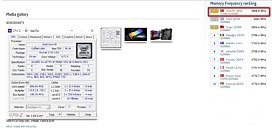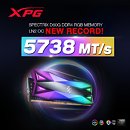So, they managed to clock a (no doubt cherrypicked) memory module like 6 Mhz higher than the previous record on LN2. Is there a point to this beyond corporate dick waving by memory companies?
Verification pic seems to be bullshit, shouldn't that be from the Memory tab?
I assume extreme RAM overclocking is its own discipline, with CPU staying at whatever low frequency it needs but memory controlelr heavily overvolted and clocked along with memory itself?
The screenshot is just what CPU-Z's leaderboard uses as the main image, since it's mainly used to verify CPU clocks, not Memory frequencies. - The actual validation can be found here:
http://valid.x86.fr/tup30u
Companies being involved in this doesn't really seem like an issue to me though - the point isn't to say "We got lucky and Samsung sold us ICs that are top 0.000001% of all Samsung B-Die, and we gave those to our overclocker so that we could claim Samsung's achievement as our own".
The point is to prove that the stuff they built to support those binned ICs, is high quality and can get the best out of them. It's well engineered, it's well built, etc.
Sure, they're expensive, halo products that probably never come close to recouping investment, and in that sense it's all marketing - but it's somewhat like F1 for computer hardware - You don't drive an F1 car. It'd be terrible to use daily. But you do drive a car with lots of technology inside that was probably developed in F1 and later adapted for road cars. That technology wouldn't have been developed without winning a "pointless dickwaving" kind of racing competition, but that racing competition is used to justify the development of technology without having to worry about the bean-counters saying that it's "too expensive to hit the pricepoint we're aiming at".
An example of that kind of design filtering down from super extreme products to more mainstream ones is the Z390 dark having only 2 memory slots and a rotated socket, solely to reduce memory trace length and therefore get higher memory clocks.
That's something that Gigabyte approached differently in the Z97 days with HiCookie, who designed motherboards without cooler mounting holes that allowed the same thing - shorter memory trace length. EVGA saw that worked and then refined the idea. Result? Z390 dark has crazy high memory frequency capability, but doesn't make the same compromise on cooler mounting (IE, literally not being able to use one unless it was an LN2 pot heavy enough to ensure good contact through weight alone, in a horizontal testbed).
Now sure, on memory, there's less you can do to "build it better" and prove your engineering prowess is superior - but it's still very much the same idea - and there's definitely something to the idea that you need to build them to a high standard to hit those high clocks - it's not all down to the memory IC to do the work - if it were, RGB DIMMs wouldn't clock lower than non-RGB DIMMs with the same memory ICs.
I say fair play to XPG for building a good product. Just like I say fair play to ASUS and EVGA for building better Motherboards. I look forward to what comes next to overshadow this generation's hardware in terms of overclocking features.








